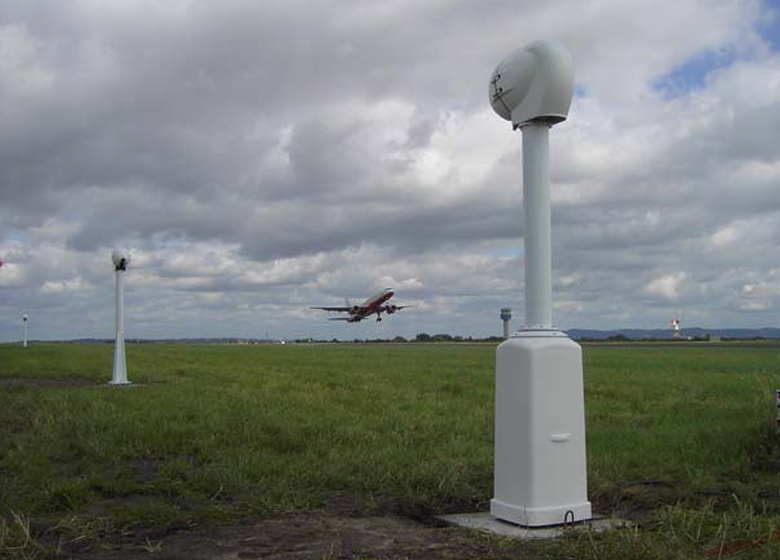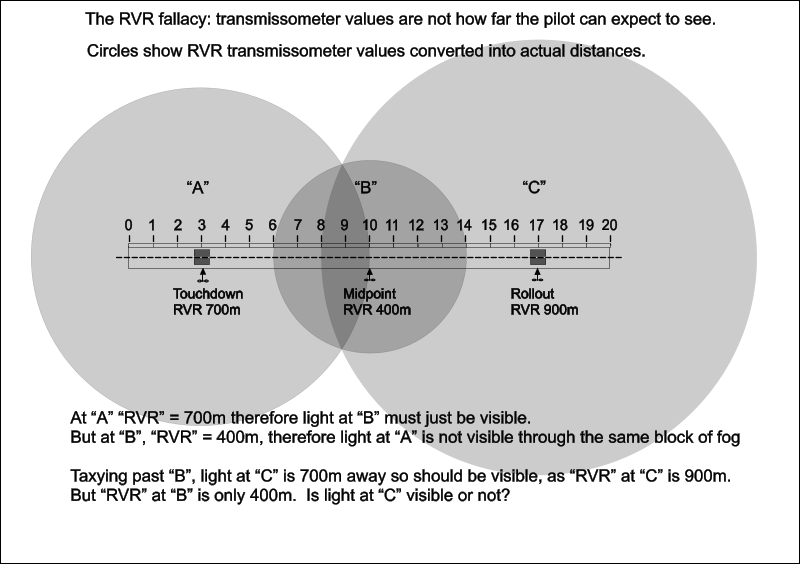What IS the "RVR"?
The definition of Runway Visual Range (RVR) is “The range over which the pilot of an aircraft on the centre line of a runway can see the runway surface markings or the lights delineating the runway or identifying its centre line.” However, despite its name, it must be recognised that what is passed to pilots as an "RVR" report is not actually the "Runway Visual Range" according to that definition.
There isn't normally a pilot in an aircraft looking down the runway centreline and saying what he can see! It is almost always a measurement by a transmissometer over a very short baseline.

Fog is often very patchy, and transmissometers can only report the true Runway Visual Range in homogeneous fog. When conditions are variable, which is probably (or even normally) the case, these reported values do NOT tell you the actual Runway Visual Range, although it's often assumed that they do.
A simple illustration of this can be seen below.
This diagram shows a 2000m runway with lights at 100m spacing. It has transmissometers 1000ft/300m from each end and at the midpoint. Reported “RVRs” are Touchdown 700m, Midpoint 400m, Rollout 900m. This is not at all an unusual set of readings.
If the Runway Visual Range at "A" (the touchdown point) is 700m, a pilot at A must be able to see light #10 at the midpoint B. So if he moves to the midpoint B and looks back, he is looking through the same mass of foggy air. So how far can he see? Nothing else has changed, so he should be able to see light #3, at A. But at B the “RVR” is reported as 400m. In that case he can only see light #6 !
Similarly, when he is taxiing past light #8, he should be able to see light #17, which is 900m away, as the rollout “RVR” is 900m - even though he would have to go through a patch of 400m to get there.
This paradoxical situation illustrates why it is important to understand that RVRs cannot be relied on to tell you what visual cues will be ACTUALLY be available, and neither do they tell the pilot what sort of fog he will encounter.
The purpose of setting a minimum RVR.
RVR minimum values are implemented via the Approach Ban, to control the overall safety level by assuring that most actual approaches will be successful. For this reason, generally once the aircraft is less than 1000 ft above the runway on its approach, the pilot may continue even if the RVR then drops below minima.
1000ft is a somewhat arbitrary value but is typically the stabilised approach "gate" by which point all approach variables must be resolved. The minimum RVR aspect of the AOM has served its purpose at this point, and the relevant factor now is the DH - and what visual reference the pilot actually finds on reaching it.
The met forecast can assist pilots in anticipating what type of fog they may encounter and hence alert them to possible problems in assessing visual cues. However, it is essential to bear in mind that several hours may have elapsed between collection of the latest forecast and making the approach, and that fog is capable of changing its nature in a much shorter time.
